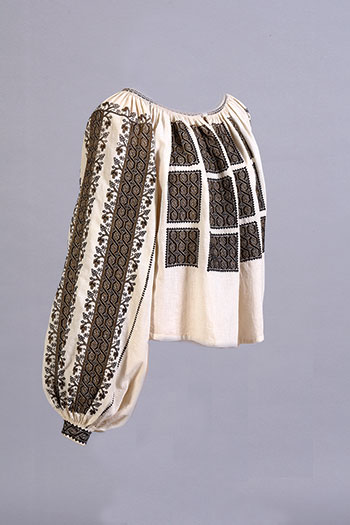NEW YORK – The Ukrainian Museum is presenting a unique cross-cultural exhibition in which Romanian and Ukrainian folk textiles will be displayed side by side for the aesthetic appreciation of museum visitors and to deepen scholarly understanding. “Carpathian Echoes: Traditional Textile Materials and Technologies in the Carpathian Mountains of Romania and Ukraine” comprises common textile materials and technologies that were characteristic of the Carpathian Mountains in both Romania and Ukraine during the 19th and early 20th centuries.
The exhibition features several complete costumes, both women’s and men’s, as well as more than 40 individual objects representative of the two neighboring cultures, demonstrating the rich, colorful and sophisticated textiles from the mountain region. It is the result of a fruitful collaboration between guest curator Dr. Florica Zaharia, conservator in charge, Department of Textile Conservation, the Metropolitan Museum of Art, and Lubow Wolynetz, curator of folk art at The Ukrainian Museum.

A sash, or “poyas” (warp double-faced weave), of the 1920s from the Hutsul region, Ivano-Frankivsk Oblast, eastern Carpathians, Ukraine. 1920s. (UM Collection)
“Carpathian Echoes” will be on view to the public from October 9 through March 12, 2017.
In the 19th and early 20th centuries, domestic textile materials were produced manually, step by step, as dictated by tradition, from the cultivation of plants and the breeding of animals to the final product, although industrialization gradually impacted the established processes in various ways. Consistent geo-climatic conditions throughout the mountain regions allowed for the production of similar materials for textiles, and created comparable needs for the home textile industry in both countries.

Detail from a “serdak,” or winter coat (woven felt), of the end of the 19th century/early 20th century from the Hutsul region, Ivano-Frankivsk Oblast, eastern Carpathians, Ukraine. (UM Collection)
The changing seasons, especially the hot summers and cold, humid winters, necessitated two types of fabrics: one made of cellulosic fibers that was ideal for summer, and the other made of proteinic fibers for winter. Various qualities of fabric called “panza” (Romanian) and “polotno” (Ukrainian) were woven of hemp, as that was the only plant fiber that could successfully be cultivated under the harsh mountain climate. Sheep wool was used for winter costumes and textiles, as well as for the woven felt called “panura” (Romanian) and “sukno” (Ukrainian) that was essential for winter. The wool was coarse, as sheep lived outdoors year-round.
Home textile production was women’s work, and the most important textiles that women made were textiles for the home and clothing. The physical, aesthetic and symbolic qualities of the materials they produced were derived from each product’s function. Plain weave, twill and tapestry weave, and embroidery were characteristic of traditional home textile production of the Carpathians, as were the associated traditions.

A woman’s vest (embroidery on sheepskin) of the end of the 19th century/early 20th century from the Banat Mountains in the southwestern Romanian Carpathians. (FARZ Collection)
Examples of costumes and textiles produced in the context of the home textile industry in the Carpathians of both Romania and Ukraine are displayed here together for the first time. For scholarly reference, materials reflecting the textile fibers and their technological transformation are also on display.
The exhibition includes a selection of pieces from the Florica, Ana and Romulus Zaharia (FARZ) Collection and from the permanent collection of The Ukrainian Museum. “Carpathian Echoes” is funded by the generous donations of individual sponsors.

A sash, or “brâu” (warp double-faced weave, patterned), of the end of the 19th century from the Craiova region, southern Carpathians, Romania. (FARZ Collection)
Tours, groups, programs
Visitors will enjoy the beauty of the Romanian and Ukrainian folk textiles on display. Docent tours offer greater depth and understanding of the objects on display. Groups of 10 or more should call at least two weeks ahead of time to reserve a tour. Teachers are encouraged to take advantage of tours and workshops for school groups as part of their history and culture curriculum. Families with young children will enjoy activities specially designed to introduce them to Ukrainіan and Romanian textiles.
Fees apply – please see the Education section on the museum’s website for details. To make reservations or request more information, call 212-228-0110 or email [email protected].

A ritual cloth, or “ștergar de divăr” (plain weave, supplementary weft, brocaded weave, weftfaced weave, embroidered, cutwork), of the late 19th century or early 20th century from the Banat region, near the southwestern Carpathians, Romania. (FARZ Collection)

A ritual cloth, or “rushnyk” (embroidery on plain weave), of the 1930s from the Hutsul region, Ivano-Frankivsk Oblast, eastern Carpathians, Ukraine. (UM Collection)
The Ukrainian Museum acquires, preserves and exhibits articles of artistic or historic significance to the rich cultural heritage of Ukrainian Americans. Its collections include thousands of items of folk art, fine art and archival material. At its founding in 1976 by the Ukrainian National Women’s League of America, the museum was hailed as one of the finest achievements of Americans of Ukrainian descent. Since then, and particularly since its move in 2005 to a new, state-of-the-art building in Manhattan’s vibrant East Village, it has become known as one of the most interesting and dynamic smaller museums in New York City.

A late 19th century woman’s shirt, or “sorochka” (embroidery on plain weave), from the Bukovyna region, Chernivtsi Oblast, eastern Carpathians, Ukraine. (UM Collection)
The Ukrainian Museum is located at 222 E. Sixth St. (between Second Avenue and the Bowery); telephone, 212-228-0110; e-mail, [email protected]; website, www.ukrainianmuseum.org. Admission: $8 for adults, $6 for seniors and students, free for children age 12 and younger.
